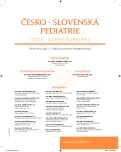Physical activity and addictive diseases: a surprising observation
Authors:
K. Nešpor 1; L. Csémy 2
Authors‘ workplace:
Oddělení léčby závislostí – muži, Psychiatrická léčebna Bohnice, Prahaprimář MUDr. K. Nešpor, CSc.
1; Laboratoř sociální psychiatrie, Psychiatrické centrum Prahavedoucí PhDr. L. Csémy
2
Published in:
Čes-slov Pediat 2013; 68 (1): 57-60.
Category:
Actual Topic
Overview
The contribution includes new and so far unpublished data from the Czech population. Adequate physical activity mitigates the craving for psychotropic substances and puts into effect in the therapy of addictive diseases. In the case of prevention in adolescents the situation is more complicated. Original data from the Czech Republic indicate that soccer, wrestling, box or kick box, anaerobic exercise and dance have been associated with increased risk of alcohol abuse in pupils of the 9th grade. Moreover, box or kick box were associated with increased abuse of marihuana. The authors presume the influence of social factors and, in case of soccer, the connection with the advertising of alcohol and hazard.
Key words:
motion activities, sports, addictive diseases, prevention
Sources
1. Angelo DL, Tavares H, Zilberman ML. Evaluation of a physical activity program for pathological gamblers in treatment. J Gambl Stud 2012 Jun 4 [Epub ahead of print].
2. Buchowski MS, Meade NN, Charboneau E, Park S, Dietrich MS, et al. Aerobic exercise training reduces cannabis craving and use in non-treatment seeking cannabis-dependent adults. PLoS One 2011; 6 (3): e17465.
3. Cropley M, Ussher M, Charitou E. Acute effects of a guided relaxa-tion routine (body scan) on tobacco withdrawal symptoms and cravings in abstinent smo-kers. Addiction 2007; 102 (6): 989–993.
4. Dahlström O, Backe S, Ekberg J, Janson S, Timpka T. Is „football for all“ safe for all? Cross-sectional study of disparities as determinants of 1-year injury prevalence in youth football programs. PLoS One 2012; 7 (8): e43795.
5. Deakin CD, Thompson F, Gibson C, Green M. Effects of international football matches on ambulance call profiles and volumes during the 2006 World Cup. Emerg Med J 2007; 24 (6): 405–407.
6. Elibero A, Janse Van Rensburg K, Drobes DJ. Acute effects of aerobic exercise and Hatha yoga on craving to smoke. Nicotine Tob Res 2011 Nov; 13 (11): 1140–1148.
7. ESPAD 2011. Evropská školní studie o alkoholu a jiných drogách, Česká republika 2011.
8. Fontes-Ribeiro CA, Marques E, Pereira FC, Silva AP, Macedo TR. May exercise prevent addiction? Curr Neuropharmacol 2011; 9 (1): 45–48.
9. Fox KR. The influence of physical activity on mental well-being. Public Health Nutr 1999; 2 (3A): 411–418.
10. Haasova M, Warren FC, Ussher M, Janse Van Rensburg K, et al. The acute effects of physical activity on cigarette cravings: Systematic review and meta-analysis with individual participant data (IPD). Addiction 2012 Aug 2 [Epub ahead of print].
11. Chen KW, Comerford A, Shinnick P, Ziedonis DM. Introducing qigong meditation into residential addiction treatment: a pilot study where gender makes a difference. J Altern Complement Med 2010; 16 (8): 875–882.
12. Janse Van Rensburg K, Taylor A, Hodgson T, Benattayallah A. Acute exercise modulates cigarette cravings and brain activation in response to smoking-related images: an fMRI study. Psychopharmacology (Berl) 2009; 203 (3): 589–598.
13. Kirkcaldy BD, Shephard RJ, Siefen RG. The relationship between physical activity and self-image and problem behaviour among adolescents. Soc Psychiatry Psy-chiatr Epidemiol 2002; 37 (11): 544–550.
14. Kujala UM, Kaprio J, Rose RJ. Physical activity in adolescence and smoking in young adulthood: a prospective twin cohort study. Addiction 2007; 102 (7): 1151–1157.
15. Lam RW, Kennedy SH. Evidence-based strategies for achieving and sustaining full remission in depression: focus on metaanalyses. Can J Psychiatry 2004; 49 (Suppl 1): 17S–26S.
16. Leeka J, Schwartz BG, Kloner RA. Sporting events affect spectators‘ cardiovascular mortality: it is not just a game. Am J Med 2010; 123 (11): 972–977.
17. Leppamaki S, Haukka J, Lonnqvist J, Partonen T. Drop-out and mood improvement: a randomised controlled trial with light exposure and physical exercise. BMC Psychiatry 2004; 11 : 22.
18. Moore MJ, Werch CE. Sport and physical activity participation and substance use among adolescents. J Adolesc Health 2005; 36 (6): 486–493.
19. Nešpor K. Uvolněně a s přehledem. Relaxace a meditace pro moderního člověka. Praha: Grada, 1998 : 1–96. Volně ke stažení z www.drnespor.eu.
20. Nešpor K. Pohybová cvičení a jóga v prevenci a léčbě závislosti. Čes a slov Psychiatr 2005; 101 (5): 268–270.
21. Nešpor K, Matanelli O, Pekárková G, Gregor P. Jak rozdělit postupy, které mírní bažení (craving). Prakt Lék 2011, 91 (12): 703–706.
22. Volkow ND. Physical activity may prevent substance abuse. NIDA Notes 2011; 23 (4): 2.
Labels
Neonatology Paediatrics General practitioner for children and adolescentsArticle was published in
Czech-Slovak Pediatrics

2013 Issue 1
- What Effect Can Be Expected from Limosilactobacillus reuteri in Mucositis and Peri-Implantitis?
- The Importance of Limosilactobacillus reuteri in Administration to Diabetics with Gingivitis
Most read in this issue
- A massive pulmonary embolism as a first symptom of nephrotic syndrome in 18-years old female patient
- Somatic development of the child and injury incidence during the pubertal spurt – new knowledge of the correlation between growth dynamics and injury risk in the present population of children
- Analysis of risk factors concerning suicidal behavior in childhood and adolescence
- Secondary malignancies in pediatric patients after hematopoietic stem cell transplantation
